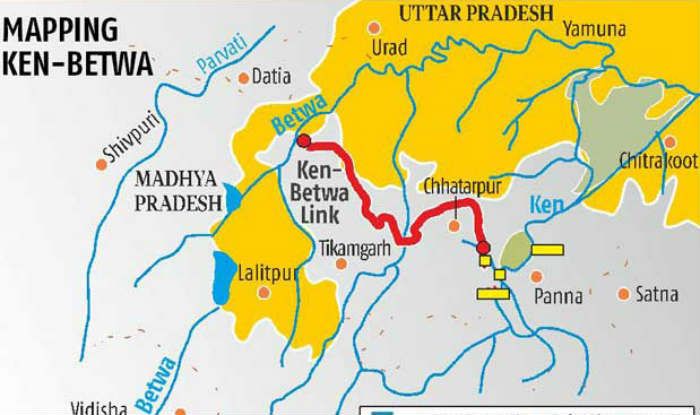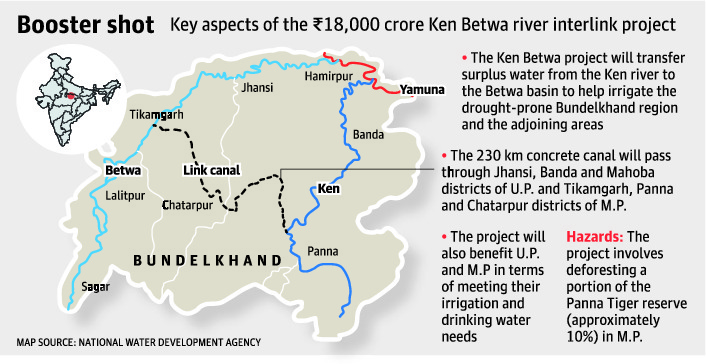India’s first river interlinking project caught in U.P.-M.P. tussle


- Observe fig below – for 30 river linking projects

Disagreements over water-sharing and difficulty in acquiring non-forest land impede the Rs. 18,000-crore Ken- Betwa river interlink project.
The project, which involves deforesting a portion of the Panna Tiger Reserve in Madhya Pradesh, was accorded clearance by the National Wildlife Board on the condition that the land lost would be made good by acquiring contiguous, revenue land. This is to ensure that wildlife corridors in the region aren’t hit.
Another hurdle is a dispute over how Uttar Pradesh and Madhya Pradesh — the two beneficiaries — will share water in the Rabi season.
Conceived as a two-part project, this is India’s first river interlinking project. It is perceived as a model plan for similar interstate river transfer missions.
Phase 1 involves building a 77 m-tall and a 2 km-wide dam, the Dhaudhan dam, and a 230 km canal to transfer extra water from the Ken river for irrigating 3.64 lakh hectares in the Bundelkhand region of Uttar Pradesh and Madhya Pradesh.
Originally, this phase envisaged irrigating 6,35,661 ha annually (3,69,881 ha in M.P. and 2,65,780 ha in U.P.).
In addition, the project was to provide 49 million cubic metres (MCM) of water for en route drinking water supply.
While there’s a 2005 agreement between Uttar Pradesh and Madhya Pradesh on how water would be shared, Madhya Pradesh said in 2017 that these assumptions were no longer valid and the only way to meet increased water requirements would be to include certain local water management projects — the Kotha barrage, Lower Orr and Bina complex that were envisaged in the second phase of the project — in the first phase.
In theory, this could mean a completely fresh environmental appraisal. The Central Water Commission is yet to officially take a call, though government sources say the Centre is agreeable to the change.
However, new demands by Madhya Pradesh for more water during the Rabi season are yet to be negotiated
About National Water Commission:
- The government of India had set up several special groups to come up with a paradigm shift in water management in the last few years. A committee headed by Mihir Shah was one such committee. The Committee, called Committee on Restructuring the Central Water Commission (CWC) and Central Ground Water Board (CGWB), headed by Shah was set up to come up with concrete proposals to address the water problems.
- It submitted its report titled, “A 21st Century Institutional Architecture for India’s Water Resources,” to the central government in July 2016. Among others, the committee recommended the creation of a new National Water Commission (NWC) as the nation’s apex facilitation organisation dealing with water policy, data and governance.
Proposed NWC:
The commission report recommended that NWC be headed by a chief national water commissioner and should have full time commissioners representing hydrology, hydrogeology, hydrometeorology, river ecology, ecological economics, agronomy (with focus on soil and water) and participatory resource planning and management.
- It will be an autonomous body & will to have a countrywide base and mandate, and greater human-power.
- It will subsume Central Water Commission & the Central Ground Water Board.
- The commission aims at reducing inter-state water disputes, bring greater efficiency, better planning and increased emphasis on conservation of water.
- It also ensures that all water resources in the country are managed in a holistic manner and not separately as surface water, groundwater or river water.
ALSO READ: MIHIR SHAH COMMITTEE ON WATER MANAGEMENT

Leave a comment